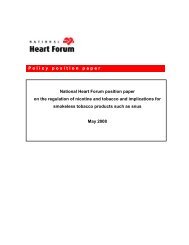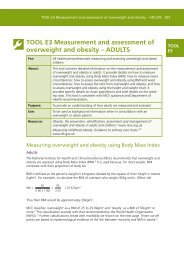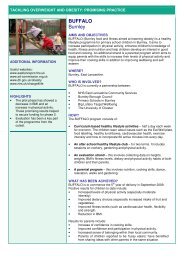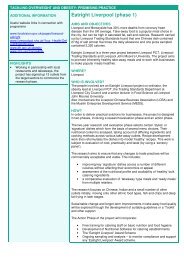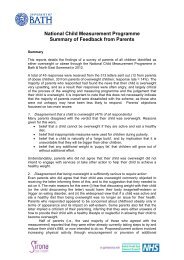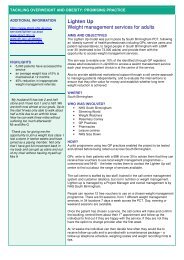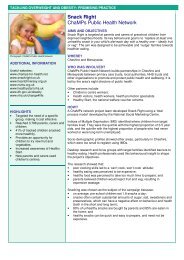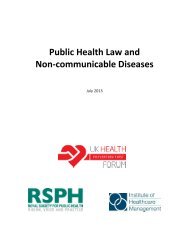The Challenge of Non-Communicable Diseases and Road Traffic ...
The Challenge of Non-Communicable Diseases and Road Traffic ...
The Challenge of Non-Communicable Diseases and Road Traffic ...
Create successful ePaper yourself
Turn your PDF publications into a flip-book with our unique Google optimized e-Paper software.
24 <strong>The</strong> <strong>Challenge</strong> <strong>of</strong> <strong>Non</strong>-communicable <strong>Diseases</strong> <strong>and</strong> <strong>Road</strong> <strong>Traffic</strong> Injuries in Sub-Saharan Africa<br />
<strong>The</strong> rate <strong>of</strong> smoking among young girls is becoming<br />
similar to boys [6] (Figure 11).<br />
Around one in ten adolescents smoke cigarettes,<br />
around one in ten use other tobacco products, <strong>and</strong><br />
half <strong>of</strong> all adolescents are exposed to second-h<strong>and</strong><br />
FIGURE 11: Current Use <strong>of</strong> Tobacco Products<br />
among African Youth, 13-15 Years, 2005-2010<br />
Botswana<br />
Burkina Faso<br />
Burundi<br />
Cameroon<br />
Cape Verde<br />
Central African Republic<br />
Chad<br />
Comoros<br />
Congo<br />
Cote d'Ivoire<br />
Democratic Republic <strong>of</strong> the Congo<br />
Eritrea<br />
Gambia, <strong>The</strong><br />
Ghana<br />
Guinea<br />
Guinea-Bissau<br />
Kenya<br />
Lesotho<br />
Liberia<br />
Madagascar<br />
Malawi<br />
Mali<br />
Mauritania<br />
Mauritius<br />
Mozambique<br />
Namibia<br />
Niger<br />
Nigeria<br />
Rw<strong>and</strong>a<br />
Senegal<br />
Seychelles<br />
Sierra Leone<br />
South Africa<br />
Swazil<strong>and</strong><br />
Togo<br />
Ug<strong>and</strong>a<br />
United Republic <strong>of</strong> Tanzania<br />
Zambia<br />
Zimbabwe<br />
Source: [32] [92]<br />
Currently using any<br />
tobacco products - female %<br />
0.0 10.0 20.0 30.0 40.0<br />
% population<br />
Currently using any<br />
tobacco products - male %<br />
smoke. For example, in 2007 in Ug<strong>and</strong>a, 5.5 percent<br />
<strong>of</strong> students were currently smoking tobacco (males<br />
6.6 percent; females 4.0 percent), <strong>and</strong> 13.9 percent<br />
were currently using other tobacco products [93].<br />
Tobacco companies are shifting their focus from<br />
the west to developing nations, <strong>and</strong> marketing heavily<br />
in Asia <strong>and</strong> Africa. This is particularly because as<br />
incomes rise, cigarettes are likely to become more affordable.<br />
Smoking is promoted as a sign <strong>of</strong> independence<br />
<strong>and</strong> success for women. <strong>The</strong> tobacco industry<br />
also takes advantage <strong>of</strong> a country’s need for economic<br />
development, promoting reliance: Botswana<br />
has recently started cigarette manufacturing, even<br />
providing incentives to companies to increase employment<br />
opportunities [94].<br />
Africa is home to some <strong>of</strong> the most tobacco-dependent<br />
economies in the world: in Malawi, 2 million<br />
people rely on growing tobacco for their livelihood,<br />
<strong>and</strong> in Nigeria British American Tobacco<br />
presents itself as a significant stakeholder in the<br />
rural economy [95]. Where nutrition is a threat to<br />
public health there is a trade<strong>of</strong>f between tobacco<br />
growth <strong>and</strong> food production, <strong>and</strong> this may in time<br />
lead to conflict over l<strong>and</strong>: in the Democratic Republic<br />
<strong>of</strong> Congo, cassava is no longer available in some<br />
places due to tobacco plantations, <strong>and</strong> has to be imported<br />
from Ug<strong>and</strong>a [94].<br />
Alcohol<br />
In SSA 2.2 percent <strong>of</strong> all deaths <strong>and</strong> 2.5 percent <strong>of</strong><br />
all DALYs are related to alcohol, <strong>and</strong> consumption<br />
is rising throughout the region [73, 96]. Africa’s total<br />
adult per capita consumption (APC) <strong>of</strong> 6.15 liters is<br />
similar to the world average, but levels differ greatly<br />
across countries [97]. Around one-third (31.4 percent)<br />
<strong>of</strong> the alcohol consumed is ‘unrecorded’, <strong>of</strong>ten<br />
being home-brewed. Beverages other than wine,<br />
beer, <strong>and</strong> spirits, such as fermented maize or millet,<br />
are mainly consumed in SSA (48.2 percent <strong>of</strong> APC),<br />
with beer accounting for around a third (34.1 percent)<br />
<strong>of</strong> APC.<br />
<strong>The</strong> African region has the highest prevalence <strong>of</strong><br />
heavy episodic (“binge”) drinking globally, present<br />
in around a quarter (25.1 percent) <strong>of</strong> those drinking,<br />
<strong>and</strong> including nearly one-third (30.5 percent) <strong>of</strong><br />
men (Table 5). While seven out <strong>of</strong> 10 adults in the



